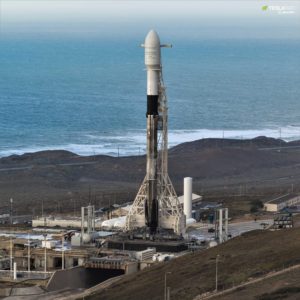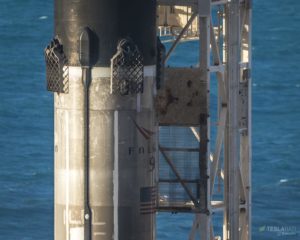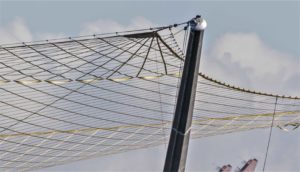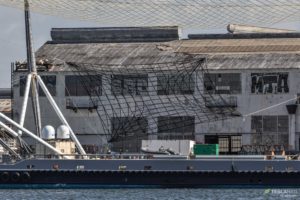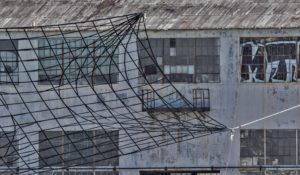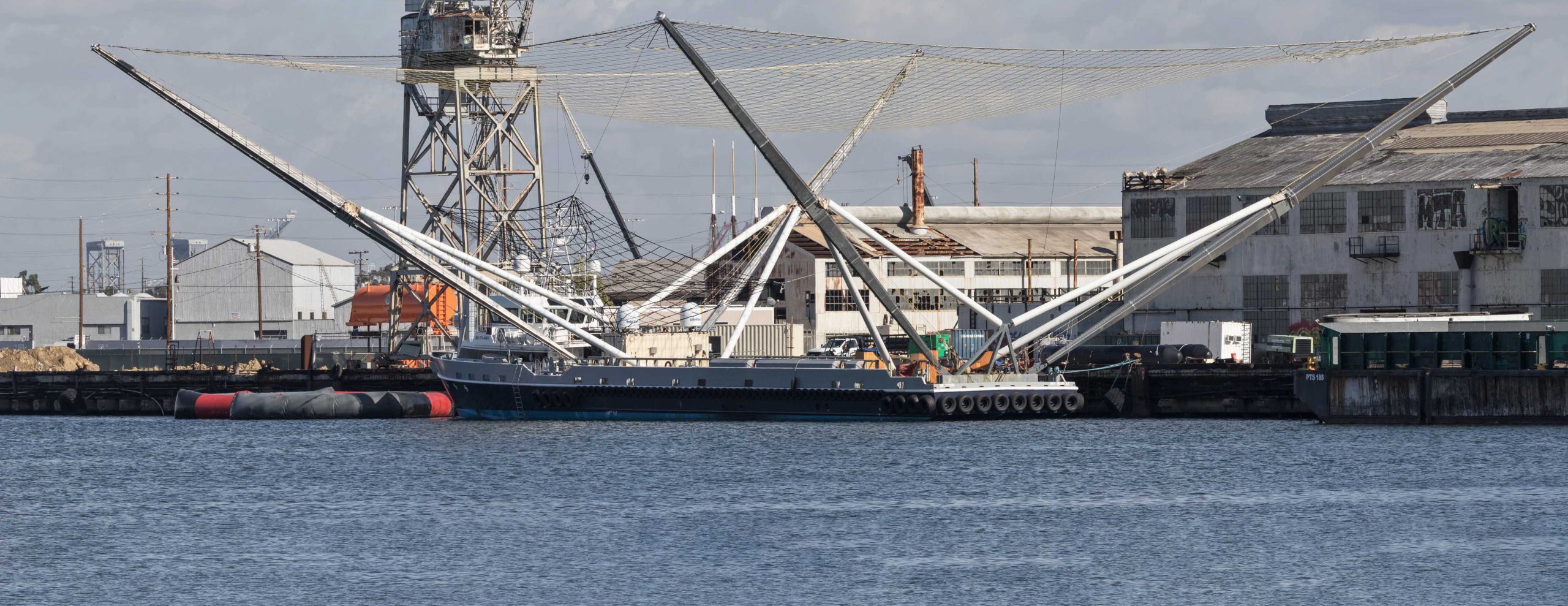
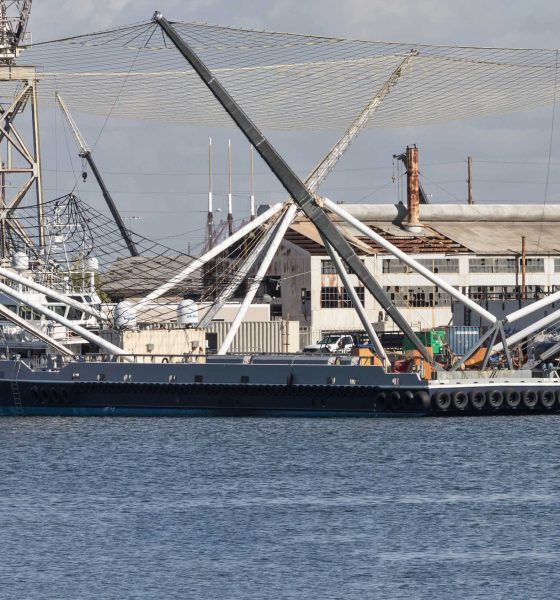
News
SpaceX fairing catcher Mr. Steven to attempt first Falcon fairing catch in months
Currently stationkeeping in the Pacific Ocean 220 miles (350 km) south of SpaceX’s Vandenberg launch pad, it’s starting to look like SpaceX fairing catcher Mr. Steven will soon attempt its first operational Falcon 9 fairing recovery in more than four months.
On the tail of the SpaceX’s fourth or fifth controlled fairing drop test, a series of tests that coincided with Mr. Steven attempting no recovery during the last West Coast launch, it’s possible that SpaceX engineers now believe the company is ready to successfully catch a fairing after an actual Falcon 9 launch. If so, the twice-flown Falcon 9’s third launch – with Spaceflight’s SSO-A satellite rideshare mission in tow – is the best chance yet for SpaceX to take its last critical step towards fairing reusability.
Good News and Bad News! Firstly, launch is pushed back a day till the 3rd. The good news is that Mr Steven's destination is set to SSO-A and might make a catch attempt! pic.twitter.com/3FNvifyRPX
— Gav Cornwell (@SpaceOffshore) December 2, 2018
Over the last four months, Mr. Steven’s crew of SpaceX and GO engineers and technicians have gradually introduced significant modifications to the vessel’s fairing recovery hardware, including major changes to the net’s motorized rigging, the installation of a curious lone arm on his bow, and – most recently – an odd mini-net that appears to be able to move around the gap between Mr. Steven’s main net and deck.
Aside from extensive (albeit subtle) hardware modifications, SpaceX workers conducted no less than four dedicated fairing drop tests, in which a helicopter would lift a specially-modified Falcon fairing half, releasing it around 10,000 feet so that it could deploy its parafoil and glide towards attempted soft landings in Mr. Steven’s net. While it’s almost impossible to know without official confirmation whether any drop test actually occurred, the fairing half involved clearly survived each trip out to sea and is currently stationed out of the way at SpaceX’s Berth 240 facilities.
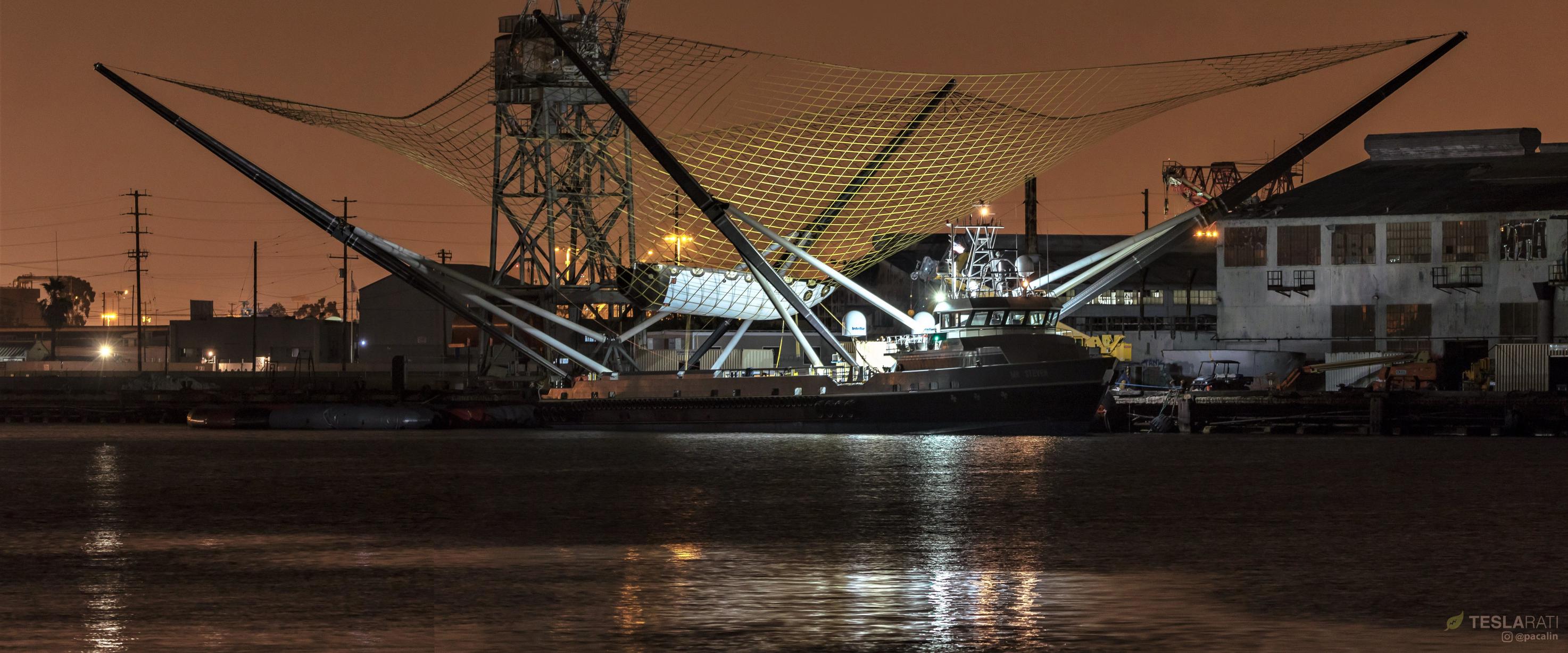
At one point, the recognizable test-specific fairing half did return to port in Mr. Steven’s net and remained there overnight, perhaps indicating that SpaceX saw some success with its experimental drop-and-catch tests. A step further, while it’s fairly easy to literally discern the changes made to Mr. Steven over the last several months, it’s impossible to know just how much the fairing’s own guidance and navigation computers (GNC) and aerodynamic control surfaces (a steerable parafoil) factored into several failed recovery attempts after launches.
More likely than not, Mr. Steven is no more responsible for ensuring fairings are caught than SpaceX’s drone ships are for Falcon 9 booster landings – the most they can typically do is be in the right spot at the right time, although Mr. Steven does admittedly have a bit more flexibility to adjust his net’s position at the last second. Given that SpaceX intentionally avoided a fairing recovery attempt during October 7’s West Coast Falcon 9 launch, choosing instead to travel to the vicinity of Catalina Island for controlled experiments, it seems improbable that SpaceX would attempt another post-launch fairing recovery unless if the program’s engineers hadn’t gained some level of additional confidence.
- A very sooty B1046 is – fingers crossed – at long last ready for its third flight after almost three weeks of delays. (Pauline Acalin)
- Soot, o’ glorious soot. (Pauline Acalin)
- Mr. Steven’s main net has sprouting a forest of additional rigging over the last month or two. (Pauline Acalin)
- Main net, meet bby net. (Pauline Acalin)
- What dat net do?
As such, the launch of SSO-A – already a milestone by thanks to its twice-flown Falcon 9 booster – may also be SpaceX’s best chance yet at successfully catching a Falcon 9 payload fairing in Mr. Steven’s net. Questions remain, of course. What does his cabled unicorn horn accomplish? Why the recent installation of a tiny secondary net? What exactly has Mr. Steven been up to lately in the Pacific Ocean? Who knows, but make sure to watch SpaceX’s launch attempt – NET 10:32 am PST (17:32 UTC) December 3rd – live tomorrow.

News
Man credits Grok AI with saving his life after ER missed near-ruptured appendix
The AI flagged some of the man’s symptoms and urged him to return to the ER immediately and demand a CT scan.

A 49-year-old man has stated that xAI’s Grok ended up saving his life when the large language model identified a near-ruptured appendix that his first ER visit dismissed as acid reflux.
After being sent home from the ER, the man asked Grok to analyze his symptoms. The AI flagged some of the man’s symptoms and urged him to return immediately and demand a CT scan. The scan confirmed that something far worse than acid reflux was indeed going on.
Grok spotted what a doctor missed
In a post on Reddit, u/Tykjen noted that for 24 hours straight, he had a constant “razor-blade-level” abdominal pain that forced him into a fetal position. He had no fever or visible signs. He went to the ER, where a doctor pressed his soft belly, prescribed acid blockers, and sent him home.
The acid blockers didn’t work, and the man’s pain remained intense. He then decided to open a year-long chat he had with Grok and listed every detail that he was experiencing. The AI responded quickly. “Grok immediately flagged perforated ulcer or atypical appendicitis, told me the exact red-flag pattern I was describing, and basically said “go back right now and ask for a CT,” the man wrote in his post.
He copied Grok’s reasoning, returned to the ER, and insisted on the scan. The CT scan ultimately showed an inflamed appendix on the verge of rupture. Six hours later, the appendix was out. The man said the pain has completely vanished, and he woke up laughing under anesthesia. He was discharged the next day.
How a late-night conversation with Grok got me to demand the CT scan that saved my life from a ruptured appendix (December 2025)
byu/Tykjen ingrok
AI doctors could very well be welcomed
In the replies to his Reddit post, u/Tykjen further explained that he specifically avoided telling doctors that Grok, an AI, suggested he get a CT scan. “I did not tell them on the second visit that Grok recommended the CT scan. I had to lie. I told them my sister who’s a nurse told me to ask for the scan,” the man wrote.
One commenter noted that the use of AI in medicine will likely be welcomed, stating that “If AI could take doctors’ jobs one day, I will be happy. Doctors just don’t care anymore. It’s all a paycheck.” The Redditor replied with, “Sadly yes. That is what it felt like after the first visit. And the following night could have been my last.”
Elon Musk has been very optimistic about the potential of robots like Tesla Optimus in the medical field. Provided that they are able to achieve human-level articulation in their hands, and Tesla is able to bring down their cost through mass manufacturing, the era of AI-powered medical care could very well be closer than expected.
News
Tesla expands Model 3 lineup in Europe with most affordable variant yet
The Model 3 Standard still delivers more than 300 miles of range, potentially making it an attractive option for budget-conscious buyers.

Tesla has introduced a lower-priced Model 3 variant in Europe, expanding the lineup just two months after the vehicle’s U.S. debut. The Model 3 Standard still delivers more than 300 miles (480 km) of range, potentially making it an attractive option for budget-conscious buyers.
Tesla’s pricing strategy
The Model 3 Standard arrives as Tesla contends with declining registrations in several countries across Europe, where sales have not fully offset shifting consumer preferences. Many buyers have turned to options such as Volkswagen’s ID.3 and BYD’s Atto 3, both of which have benefited from aggressive pricing.
By removing select premium finishes and features, Tesla positioned the new Model 3 Standard as an “ultra-low cost of ownership” option of its all-electric sedan. Pricing comes in at €37,970 in Germany, NOK 330,056 in Norway, and SEK 449,990 in Sweden, depending on market. This places the Model 3 Standard well below the “premium” Model 3 trim, which starts at €45,970 in Germany.
Deliveries for the Standard model are expected to begin in the first quarter of 2026, giving Tesla an entry-level foothold in a segment that’s increasingly defined by sub-€40,000 offerings.
Tesla’s affordable vehicle push
The low-cost Model 3 follows October’s launch of a similarly positioned Model Y variant, signaling a broader shift in Tesla’s product strategy. While CEO Elon Musk has moved the company toward AI-driven initiatives such as robotaxis and humanoid robots, lower-priced vehicles remain necessary to support the company’s revenue in the near term.
Reports have indicated that Tesla previously abandoned plans for an all-new $25,000 EV, with the company opting to create cheaper versions of existing platforms instead. Analysts have flagged possible cannibalization of higher-margin models, but the move aims to counter an influx of aggressively priced entrants from China and Europe, many of which sell below $30,000. With the new Model 3 Standard, Tesla is reinforcing its volume strategy in Europe’s increasingly competitive EV landscape.
News
Tesla FSD (Supervised) stuns Germany’s biggest car magazine
FSD Supervised recognized construction zones, braked early for pedestrians, and yielded politely on narrow streets.
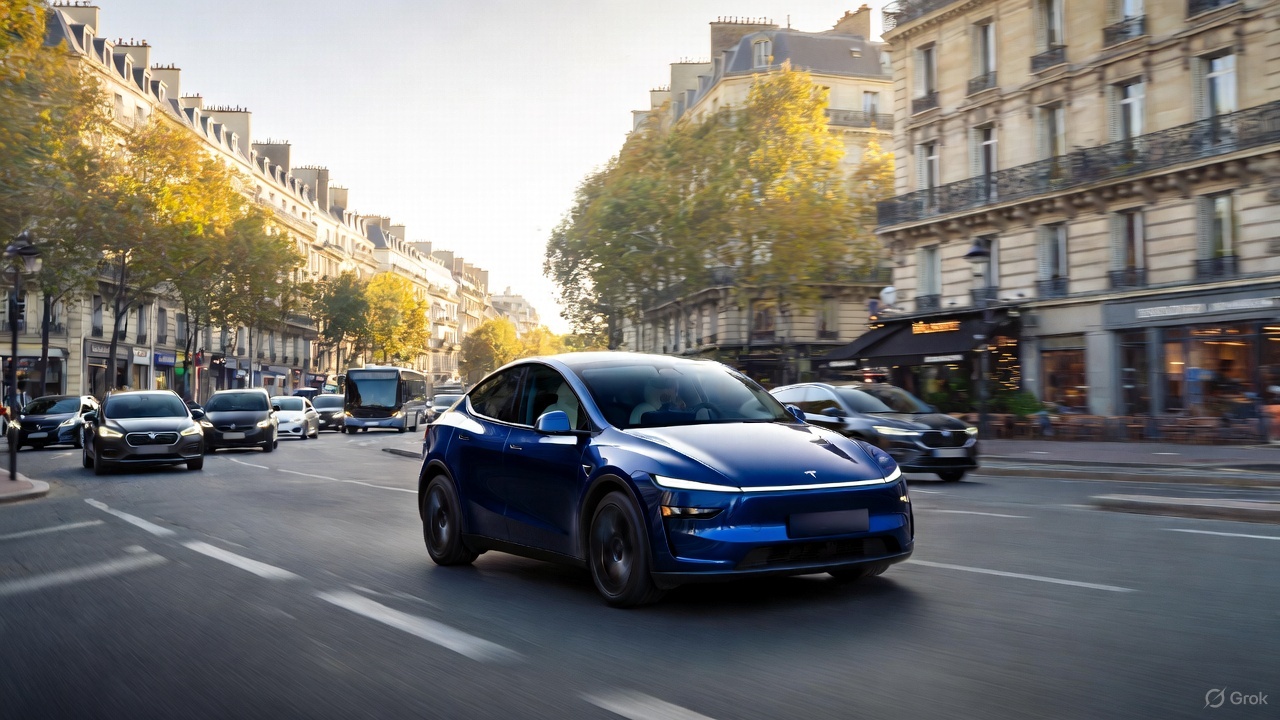
Tesla’s upcoming FSD Supervised system, set for a European debut pending regulatory approval, is showing notably refined behavior in real-world testing, including construction zones, pedestrian detection, and lane changes, as per a recent demonstration ride in Berlin.
While the system still required driver oversight, its smooth braking, steering, and decision-making illustrated how far Tesla’s driver-assistance technology has advanced ahead of a potential 2026 rollout.
FSD’s maturity in dense city driving
During the Berlin test ride with Auto Bild, Germany’s largest automotive publication, a Tesla Model 3 running FSD handled complex traffic with minimal intervention, autonomously managing braking, acceleration, steering, and overtaking up to 140 km/h. It recognized construction zones, braked early for pedestrians, and yielded politely on narrow streets.
Only one manual override was required when the system misread a converted one-way route, an example, Tesla stated, of the continuous learning baked into its vision-based architecture.
Robin Hornig of Auto Bild summed up his experience with FSD Supervised with a glowing review of the system. As per the reporter, FSD Supervised already exceeds humans with its all-around vision. “Tesla FSD Supervised sees more than I do. It doesn’t get distracted and never gets tired. I like to think I’m a good driver, but I can’t match this system’s all-around vision. It’s at its best when both work together: my experience and the Tesla’s constant attention,” the journalist wrote.
Tesla FSD in Europe
FSD Supervised is still a driver-assistance system rather than autonomous driving. Still, Auto Bild noted that Tesla’s 360-degree camera suite, constant monitoring, and high computing power mark a sizable leap from earlier iterations. Already active in the U.S., China, and several other regions, the system is currently navigating Europe’s approval pipeline. Tesla has applied for an exemption in the Netherlands, aiming to launch the feature through a free software update as early as February 2026.
What Tesla demonstrated in Berlin mirrors capabilities already common in China and the U.S., where rival automakers have rolled out hands-free or city-navigation systems. Europe, however, remains behind due to a stricter certification environment, though Tesla is currently hard at work pushing for FSD Supervised’s approval in several countries in the region.
